6

About the Author:
My name is Lindsey Bronold, I myself graduated from Ferris State University (FSU) with my Bachelors of Social Work in 2016, and my Masters of Social Work in 2017; go bulldogs! Throughout my academic journey I was able to gain incredible experiences in the field through my undergraduate and graduate level internships. My internship experiences include working with victims of domestic violence and sexual assault at Women’s information Services Incorporated, working with Community Mental Health practicing crisis intervention and stabilization, and practicing medical social work at Spectrum Health Butterworth Hospital. Since graduating in August 2017, I am currently working as a crisis stabilization specialist for Community Mental Health, as I have found that working in the field of mental health is where I am most passionate. I hope you too will find your passion within the field of social work as I am hopeful that this book will provide you with insight on many of different practice areas. Good luck in your studies and go bulldogs!
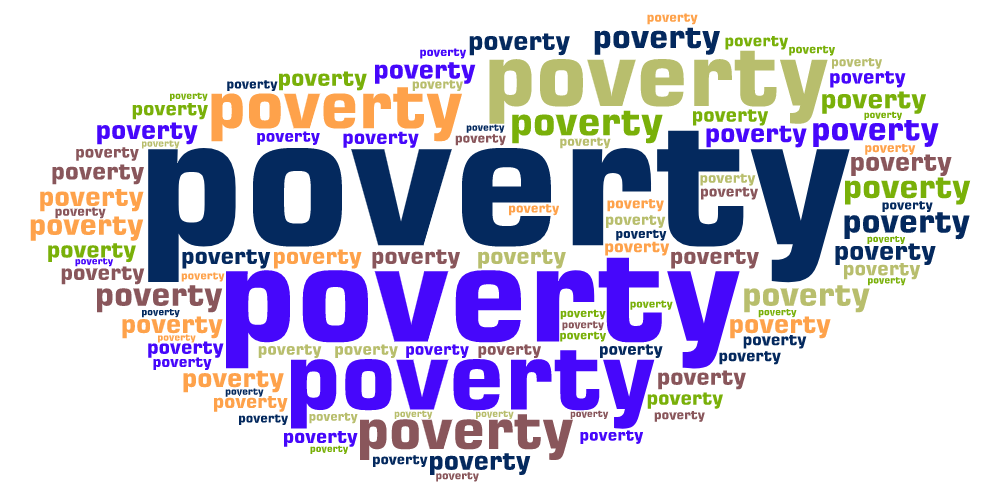
Introduction to Poverty
“Poverty is hunger. Poverty is lack of shelter. Poverty is being sick and not being able to see a doctor. Poverty is not having access to school and not knowing how to read. Poverty is not having a job, is fear for the future, living one day at a time.
Poverty has many faces, changing from place to place and across time, and has been described in many ways. Most often, poverty is a situation people want to escape. So poverty is a call to action — for the poor and the wealthy alike — a call to change the world so that many more may have enough to eat, adequate shelter, access to education and health, protection from violence, and a voice in what happens in their communities.” – The World Bank Organization
Although poverty is one of the most familiar and enduring conditions known to humanity, it is a highly complicated concept to understand fully. Above is a definition of poverty given by The World Bank Organization. To date there is no one standard definition of poverty, but numerous definitions and descriptions. All current definitions and descriptions agree that poverty is a complex societal problem.
Regardless as to how poverty is defined, it can be agreed that it is a problem requiring everyone’s attention. It is important that all members of our society work together to provide opportunities for all members to reach their full potential. It helps all of us to help one another.
Poverty looks different across the world. Commonly when we think of poverty, we relate it to the images we see on television of malnourished children living in developing countries. However, poverty is all around us. Even in the wealthiest of countries poverty still exists. Individuals who are living in poverty are made up of all races, ethnicities, ages, backgrounds, and geographic locations (Rodgers, 2015). For many individuals living in poverty, their lives are characterized by low wages, unemployment, underemployment, little property ownership, no savings, and lack of food reserves. The ability to meet even the most basic needs is in constant jeopardy. Feelings of helplessness, dependence, and inferiority develop easily under these circumstances (Sue, Rasheed, & Rasheed, 2012).
Absolute and Relative Poverty
When discussing poverty the terms absolute poverty and relative poverty are often used (Iceland, 2013). Absolute and relative are the two most common forms of poverty delineated in our society and around the world (Pierson & Thomas, 2010).
Absolute poverty
Absolute poverty refers to the amount of money necessary to meet basic needs such as food, clothing, and shelter. The concept of absolute poverty is not concerned with the broader quality of life issues or with the overall level of inequality in society but is based strictly on whether or not basic needs are being met (UNESCO, 2017). Examples of absolute poverty would include not knowing when or where your next meal will come from, not having access to clean drinking water, and not having an adequate place to sleep each night.
Relative poverty
Relative poverty refers to the lack of resources to obtain the types of diet, participate in the activities, and have the living conditions and amenities that are customary to maintain the average standard of living in society (Pierson, & Thomas, 2010; Poverty eradication, 2012). Relative poverty defines poverty in relation to the economic status of other members of the society, therefore determining if people are poor by gauging if they fall below normal standards of living in a given society (UNESCO, 2017). Examples of relative poverty would include not being able to have your children participate in after school activities, not being able to afford to dine out, or not being able to take vacations.
Three degrees of poverty
Evaluating poverty can be broken down into three different levels; the first and most severe is extreme poverty, the second is moderate poverty, and the third is relative poverty.
Extreme poverty
Extreme poverty is the most extensively discussed and researched degree of poverty due to its widespread effect around the world. Those living in extreme poverty are considered the poorest in the world (Harack, 2010). Individuals and families who live in extreme poverty cannot meet their basic needs for survival. These individuals frequently may not have access to food, safe drinking water, shelter, medical care, clothing, and educational opportunities, making everyday life a challenge (Poverty eradication, 2012, The World Bank, 2015).
Moderate poverty
Moderate poverty can be characterized when individuals and families can usually meet their basic needs but commonly face struggles in doing so (Poverty eradication, 2012). Individuals living in moderate poverty are in less danger than those living in extreme poverty. These individuals usually lack much, if any disposable income, but the majority, if not all of their basic needs are being met. Those living in moderate poverty may not be struggling to survive, but this type of poverty does make it difficult for individuals to progress in society and escape poverty completely (Harack, 2010).
Relative poverty: refer to the section above.
Measuring poverty in the United States
In the United States, there are two official poverty measures. Poverty thresholds are the primary version of the federal poverty measure and the second measure being poverty guidelines.
Poverty thresholds
Poverty thresholds were developed in the mid-1960s by Mollie Orshansky, a staff economist at the Social Security Administration. Orshansky created the poverty threshold by determining the cost of a minimum food diet and then multiplied the cost by three to account for other family expenses (United States Census Bureau, 2016). The U.S Census Bureau updates the threshold annually to account for inflation using the Consumer Price Index (Institute for Research on Poverty, 2016).
The U.S. Census Bureau determines poverty status by comparing pre-tax cash income against the threshold that has been set for that year (Institute for Research on Poverty, 2016). If the family’s total income is less than the family’s threshold, then that family and every individual in it is considered to be living in poverty (United States Census Bureau, 2016). According to the U.S Census Bureau in 2015, the most recent year for which data is available, the poverty threshold for a family of four was $24,257, and the official poverty rate was 13.5 percent (Institute for Research on Poverty, 2016). Based on the poverty threshold data it was concluded there were 43.1 million people in the United States living in poverty in 2015 (Institute for Research on Poverty, 2016; Proctor, Semega, & Kollar, 2016).
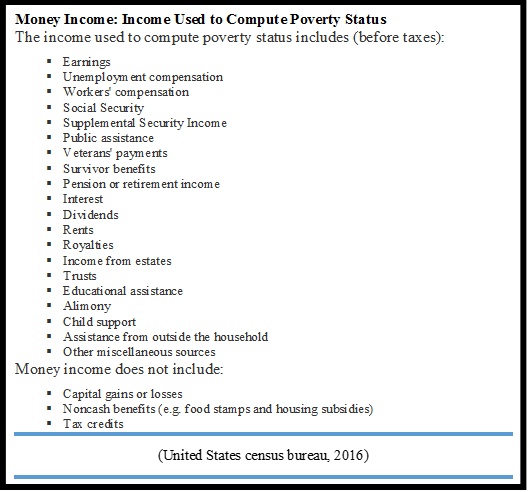
The poverty thresholds are primarily used for statistical purposes which include tracking poverty over time, poverty rates, and comparing poverty across different demographic groups. Furthermore, the data obtained from the poverty thresholds is used to create and develop annual poverty guidelines. (United States Census Bureau, 2016; Institute for Research on Poverty, 2016)
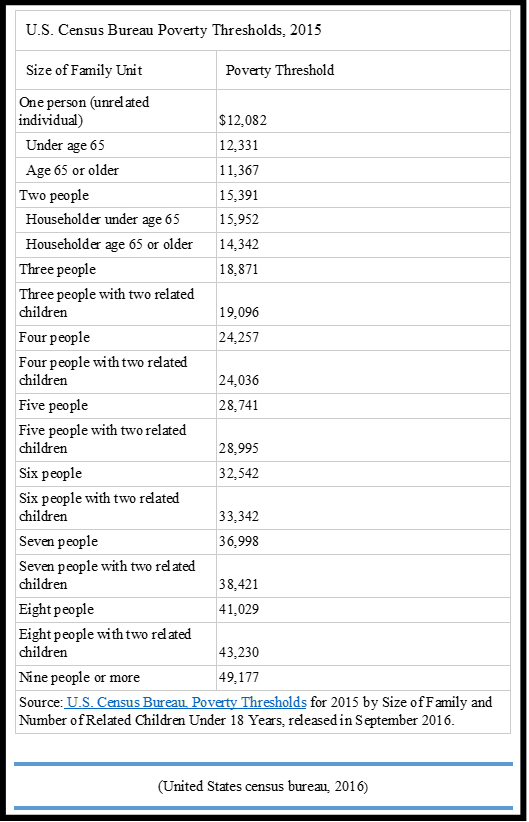
Poverty guidelines are the other official federal poverty measure used in the United States. The poverty guidelines are a simplification of the poverty thresholds utilized by the federal government to determine an individual’s eligibility for select federal programs (DHHS, 2017).
Updated poverty guidelines are issued every year by the U.S. Department of Health and Human Services (DHHS) (Institute for Research on Poverty, 2016). The 2017 poverty guidelines were determined using data taken from the 2015 poverty thresholds; the updated guidelines take economic changes taken into account.
Examples of federal programs that use poverty guidelines to determine eligibility include the following:
- Department of Health and Human Services: Community Services Block Grant, Head Start, Low-Income Home Energy Assistance
- Department of Agriculture: Supplemental Nutrition Assistance Program (SNAP, formerly Food Stamp Program), National School Lunch Program, Child and Adult Care Food Program
- Department of Energy: Weatherization Assistance for Low-Income Persons
- Department of Labor: Job Corps, National Farmworker Jobs Program, Workforce Investment Act Youth Activities
(Institute for Research on Poverty, 2016)
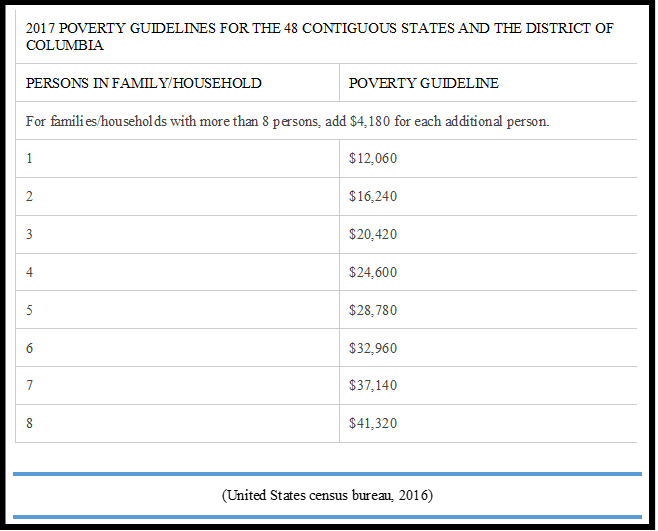
Even though the current official poverty measures have been used consistently since the 1960s, there are widespread concerns that the federal poverty measure is flawed. There is an overarching agreement that the Census Bureau does not identify all individuals living in poverty. The Census Bureau is unable to obtain exact numbers because many low-income individuals live with others or are frequently moving, and are in many cases homeless; furthermore, those residing in psychiatric hospitals, college dorms, nursing homes, serving in the military, and/or in jails or prisons are not counted. It is estimated that several million individuals who likely would fall below the poverty threshold and poverty guidelines are not counted each year (Rodgers, 2015).
For annual updates on poverty thresholds and poverty guidelines and further information on measuring poverty, please visit:
- United States Census Bureau at https://www.census.gov/topics/income-poverty.html
- The U.S Department of Health and Human Services at https://aspe.hhs.gov/poverty-guidelines
Measuring Global Poverty
International poverty line
Currently, global poverty is measured by the international poverty line. The international poverty line is a monetary threshold under which an individual is considered to be living in extreme poverty. It is calculated by taking the poverty threshold from each country, given the value of the goods needed to sustain one adult, and converting it to dollars (The World Bank, 2015).
The international poverty line was developed by The World Bank Organization and a team of independent researchers in order to gauge the number of individuals living in poverty around the world. The researchers examined national poverty lines from most impoverished countries around the world and converted the lines into a common currency by using purchasing power parity (PPP) exchange rates. The PPP exchange rates warrant that the same amount of goods or services are priced equivalently across the nation. Once converted into common currency, it was determined that the value of the national poverty line was $1 per day per person in the 1990s (The World Bank, 2015).
Since the first national poverty line was developed, it has been revised twice, first in the mid-2000s when the line rose to $1.25 per person per day after the collection of additional countries’ poverty lines and further data on internationally comparable prices were collected. The second and most recent revision was released in 2015 when the international poverty line rose again to $1.90 per person per day (The World Bank, 2015). Unlike the United States, official poverty measures for the international poverty line does not have a set schedule as to when or how often the line is revised.
For further information on global poverty and how it is measured please visit: The World Bank http://www.worldbank.org/
Poverty in America
Poverty in America is much different than the poverty in third world countries. The standard of what constitutes poverty in the United States is much different than the global standard of poverty (Iceland, 2013). Even though the United States is one of the wealthiest countries in the world, the effects of poverty are crippling.
An example of what living in poverty looks like in America is a single parent who works full time, but still can’t afford to pay for food, rent, child care, medical bills, and the costs of transportation to work (Results, 2017).
Each year millions of Americans live in poverty. The United Sates Census Bureau reports that in 2015, there were 43.1 million people in poverty (Proctor, Semega, & Kollar, 2016). A wide array of Americans from all races, ethnicities, ages, backgrounds, and geographic locations make up the 43.1 million people currently living in poverty. Some groups are more vulnerable to poverty. The most vulnerable groups make up most of the impoverished population (Rodgers, 2015). The groups that are more susceptible to suffer poverty include single parent families (especially those headed by women), minorities, unemployed or under-employed adults, individuals with mental illness or disabilities, and the elderly (Rodgers, 2015).
Poverty is said to be America’s most serious and costly social problem (Rodgers, 2015). High levels of poverty result in many serious social and political consequences. Individuals living in poverty frequently feel alienated from a conventional society which can provoke social disorder. Individuals living in poverty also often feel overlooked in the political realm, further reducing the individual’s confidence in democratic institutions (Iceland, 2013).
Each year hundreds of billions of public and private dollars are spent on efforts to prevent poverty and assist those living in poverty (Rodgers, 2015). To many, it may seem that the efforts put forth to end poverty have not made an impact. However, the most up to date data attainable from the United States Census Bureau shows that there have been improvements. In 2015, for the first time in five years, the number of individuals living in poverty had decreased. The official poverty rate was down to 13.5%, 1.2% lower than in 2014, equaling 3.5 million fewer people living in poverty (Proctor, Semega, & Kollar, 2016). Although we may never see poverty completely eradicated in our lifetime, it is hopeful that poverty will continue to decrease in the coming years.
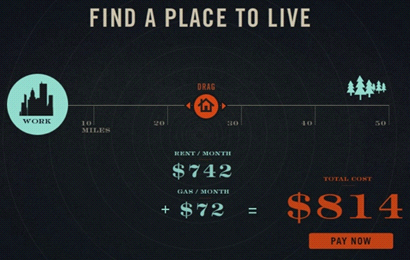
Online poverty simulation game; click link to play: http://playspent.org/html/
Homelessness
Similar to the term poverty, there are numerous definitions for the term homeless or homelessness. We have chosen to use the definition of homeless used by the Department of Health and Human Services (DHHS) that was created by, and in conjunction with, the Health Resource and Service Administration (HRSA). It is as follows:
“A homeless individual is defined in section 330(h)(5)(A) as ‘an individual who lacks housing (without regard to whether the individual is a member of a family), including an individual whose primary residence during the night is a supervised public or private facility (e.g., shelters) that provides temporary living accommodations, and an individual who is a resident in transitional housing.” A homeless person is an individual without permanent housing who may live on the streets; stay in a shelter, mission, single room occupancy facilities, abandoned building or vehicle; or in any other unstable or non-permanent situation’ (National Health Care for Homeless Council, 2017, para. 2).
Who is experiencing homelessness?
The current 2016 statistics on homelessness in the United States are derived from The 2016 Annual Homeless Assessment Report (AHAR) to Congress.
- According to the AHAR the number of individuals experiencing homelessness on any given night in 2016 was 549,928.
- Among the 549,928 individuals who experience homelessness each night in the United States vary by age, race, sex, and other classifiable characteristics.
- According to AHAR, 69% of homeless individuals were over the age of 24, 22% were children and adolescents under the age of 18, and 9% were between the ages of 18 and 24.
- The AHAR reports that 60% of the individuals experiencing homelessness were men, 40% were women, and less than 1% were transgender.
- As for race, the AHAR reports that nearly half of all people experiencing homelessness were white totaling 48%, African Americans 39%, multiracial individuals 7%, and Native Americans, Asians, and Pacific Islanders made up the remaining 6%.
The data collected from the 2016 AHAR to Congress further concluded that homelessness and poverty affects all individuals regardless of age, sex, or race.
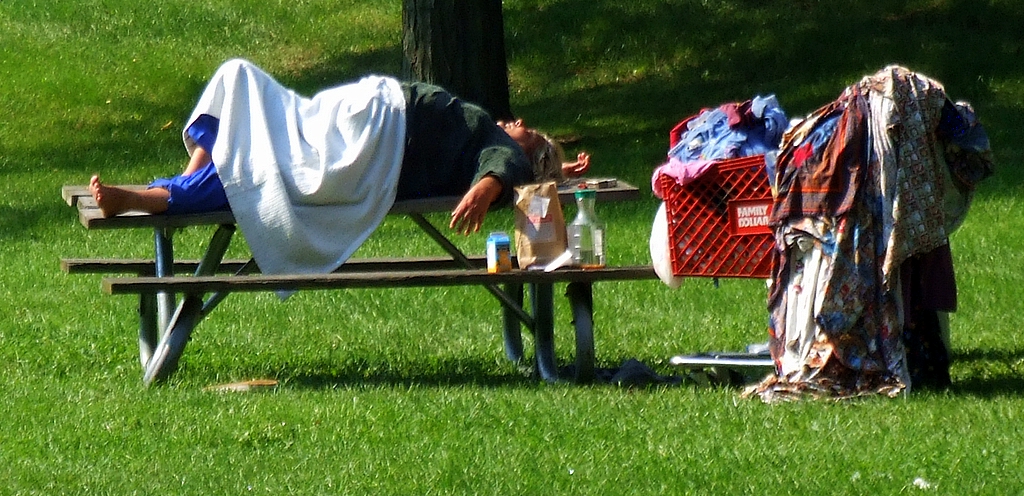
Sheltering the Homeless
All information below is from The 2016 Annual Homeless Assessment Report (AHAR).
There are various resources for homeless individuals within the United States to gain safe shelter overnight or for temporary amounts of time. The following are some of the well-known homeless resources in the United States:
Emergency Shelter is a facility with the primary purpose of providing temporary shelter for homeless people
Rapid Rehousing is a housing model designed to provide temporary housing assistance to people experiencing homelessness, moving them quickly out of homelessness and into permanent housing.
Safe Havens are projects that provide private or semi-private long-term housing for people with severe mental illness and are limited to serving no more than 25 people within a facility.
Transitional Housing Programs provide people experiencing homelessness a place to stay combined with supportive services for up to 24 months.
Even with the implementation of the programs listed above, many homeless individuals remain unsheltered on any given night within the United States. Statistics show that 68% (373,571 people) were staying in emergency shelters, transitional housing programs, or safe havens, while 32% (176,357 people) were staying in unsheltered locations.
Rural vs Urban Homelessness
In our society, homelessness is often depicted as an urban problem. Urban areas are known to have a higher population of homeless individuals than in rural areas of the county. However, there is an increasing number of homeless individuals in rural America (National Alliance to End Homelessness, 2010). Geographical location makes a difference to the resources available for those experiencing homelessness, and sadly those living in rural America are often overlooked.
Rural areas face different barriers than urban areas when it comes to serving individuals experiencing homelessness. These barriers include lack of available, affordable housing, limited transportation methods and limited employment opportunities; federal grants and programs also tend to be dispersed in more urban areas (National Alliance to End Homelessness, 2010). The lack of federal funding in rural areas causes a problem when trying to house the homeless. Due to this lack of funding there typically are not homeless shelters in rural areas, causing individuals experiencing homelessness in these areas to sleep in cars, campers, tents because shelter is not available.
Affordable Housing:
There are countless reasons as to why or how an individual becomes homeless, but research shows the key reason as to why he or she cannot escape homelessness is because the individual cannot afford housing. The United States is currently experiencing an extreme shortage of affordable housing (National Alliance to End Homelessness, 2017). The two main types of affordable housing are Public Housing and the Housing Choice Voucher Program (HCVP) which was formerly known as Section 8. It is not uncommon for Public Housing programs and the HCVP to have wait lists that are several years out.
Housing Voucher Program: This program provides vouchers to low-income households to help them pay for housing in the private market and has been found to sharply reduce homelessness (National Alliance to End Homelessness, 2017).
Public Housing: Federally-funded housing that is rented at subsidized rates to eligible low-income families, the elderly, and persons with disabilities.
Federal Government Response to Poverty: Welfare
The United States laid its foundation for a national welfare system in response to the Great Depression that started in 1929 and went through most of the 1930s. The Social Security Act of 1935 was the first of many government policies and welfare programs created to combat poverty and economic hardships (Rodgers, 2015).
The welfare system in the United States consists of government programs which provide financial assistance to individuals and families who cannot support themselves. Welfare programs are funded by taxpayers and allow people to cope with financial stress during challenging periods of their lives. The goals of welfare include the attainment of work, education, and an overall better standard of living and decrease in economic hardship and poverty.
Welfare programs
Since the establishment of Social Security Act of 1935, the federal government has continued to develop numerous welfare programs to attempts to eradicate poverty and the economic hardships faced by millions of Americans.
Key programs to combat poverty include but are not limited to the following:
All information below is from the Center for Poverty Research
1935: The Social Security Act
Part of President Franklin Roosevelt’s New Deal legislation, the original act included grants to states for unemployment compensation, aid to dependent children and public health. Today, Social Security is the largest safety net program in the U.S.
1935: Unemployment Insurance
Unemployment insurance was a part of President Franklin Roosevelt’s 1935 Social Security Act. Today’s U.S. Department of Labor Unemployment Insurance (UI) programs provides benefits to eligible workers who become unemployed through no fault of their own and who meet certain requirements.
1964: Head Start
This pre-school education program was a part of the 1964 Economic Opportunity Act that was designed to reduce disparities among young children. The 1994 Head Start Act Amendments established the Early Head Start program, which expanded the benefits of early childhood development to low-income families with children under three years old.
1964: Supplemental Nutrition Assistance Program (SNAP)
The first Food Stamp program ran from 1939-43, but the program we know today was established with the 1964 Food Stamp Act. The program is now known as the Supplemental Nutrition Assistance Program.
1965: Medicare/Medicaid
These health programs were established with amendments to the Social Security Act in 1965. Today, Medicare provides health insurance for people over 65 years of age and some younger than that but who have certain disabilities or diseases. Medicaid is a Federal and state partnership that provides health coverage for people with low income.
1972: Supplemental Security Income Program (SSI)
SSI is a Federal program that provides income people 65 or older as well as to blind or disabled adults and children.
1972: Women, Infants, and Children (WIC)
WIC is a nutrition program that benefits pregnant women, new mothers and young children who live near poverty and who are at nutritional risk. WIC is not an entitlement program, so the number of people who receive the benefits depends on the amount Congress allots for the program from year to year.
1972: Federal Pell Grant Program
Pell Grants help pay for tuition and other expenses for low-income college students.
1975: The Earned Income Tax Credit (EITC)
The EITC is a tax credit that benefits working people who have low to moderate income, especially families.
1996: Temporary Assistance for Needy Families (TANF)
TANF issues federal grants to states for programs that provide temporary benefits to families with children when the income does not provide for the family’s basic needs. Programs include job preparation, family planning, and other benefits as well as cash assistance.
1997: Children’s Health Insurance Program (CHIP)
CHIP provides health coverage to nearly eight million children in families who cannot afford private health insurance but who have incomes that are too high to qualify for Medicaid.
According to the United States Census Bureau in 2012, there were approximately 52.2 million (or 21.3 %) people in the United States receiving some sort of assistance through government funded welfare programs (United States Census Bureau, 2016). To receive assistance from government funded programs individuals must meet a certain criteria to be eligible; each program has their own distinct criteria. To apply to these programs individuals must go through state Departments of Health and Human Services (DHHS).
For further information on government funded assistance programs please visit:
- The U.S. Department of Health and Human Services, at https://www.hhs.gov/programs/social-services/index.html
- Benefits. Gov Your Path to Government Benefits, at https://www.benefits.gov/
Poverty Stigmas and Stereotypes
Stigmas
In the United States individuals living in poverty are not only faced with their day to day hardships but also with the harsh stigmas that society has surrounding poverty. When evaluating stigmas surrounding poverty, they typically fall into three categories: institutional, social, and personal stigmas (Bell, 2012; Inglis, 2016):
Institutional Stigmas: institutional level stigma can be seen in laws, policies and institutional practices that discriminate against, or shame individuals living in poverty (Inglis, 2016). Institutional stigma is that which arises from the process of claiming benefits (Bell, 2012)
Social Stigmas: Social stigma includes public attitudes toward poverty and welfare, and are typically measured through national surveys (Inglis, 2016). Social stigma is the feeling that other people judge claiming benefits to be shameful (Bell, 2012)
Personal Stigmas: Personal stigma occurs when individuals internalize the various forms of stigma and discrimination that they experience or perceive from others (Inglis, 2016). Personal stigma is a person’s own feeling that claiming benefits is shameful (Bell, 2012).
Stereotypes
Furthermore, society holds many stereotypes about individuals living in poverty. A stereotype can be defined as an often unfair and untrue belief that many people have about all people with a specific characteristic (Stereotype, 2017). The stereotypes that society has labeled individuals living in poverty are usually false. Some of the most common stereotypes and misconceptions of individuals living in poverty include:
- Individuals living in poverty are lazy and have weak work ethics
In reality, there is no suggestion that individuals living in poverty are lazier or have weaker work ethics than individuals from other/higher socioeconomic groups. In fact, poor working adults work, on average, 2,500 hours per year, the rough equivalent of 1.2 full-time jobs often patching together several part-time jobs in order to support their families (Gorski, 2013)
- Individuals living in poverty have problems with substance use
In reality, research has shown that low-income individuals are less likely to use or abuse substances than their wealthier counterparts (Gorski, 2013).
Stigmatizing and stereotyping individuals living in poverty only further creates a divide between low-income people who are living in poverty and those who are not (Inglis, 2016). Society’s harsh views on poverty cause impoverished individuals to further feel socially excluded and ashamed of the situation they are in. Research has shown negative effects on an individual’s self-esteem, self-concept, and mental and physical health due to being stigmatized and stereotyped so severely by society (Inglis, 2016).
Theories and Explanations of Poverty
There are many theories that attempt to explain poverty and why it exists. A theory in simple terms can be defined as idea or a structure of ideas intended to explain something (Theory, 2017). You will learn more about theories in-depth in higher level social work courses.
The following are some of the most commonly used theories to explain the existence of poverty.
The Culture of Poverty
The culture of poverty theory was created by the anthropologist Oscar Lewis in 1959. The culture of poverty is the theory that certain groups and individuals persist in a state of poverty because they have distinct beliefs, values, behavior, and attitudes that are incompatible with economic success (Pierson, & Thomas, 2010). Therefore, the individuals are unable to get out of poverty.
The Cycle of Poverty
The cycle of poverty is also commonly known as the cycle of deprivation. The cycle of deprivation is a theoretical explanation for the persistence of poverty. The theory focuses on how attitudes, values, and behaviors are passed on from one generation to the next, further explaining the ongoing cycle of low educational attainment, unemployment, poor housing and so on within families and communities (Pierson & Thomas, 2010).
As discussed in the explanation of the cycle, poverty is passed down generationally, meaning that children and adolescents are targeted victims falling into the cycle of poverty and not getting out of it. There is much research that indicates that children and adolescents who grow up in poverty suffer significant disadvantages, not just as children but throughout their lifespan. Alarming statistics report that children who grow up in poverty are twice as likely to drop out of school and are one and half times more likely to be unemployed (Rodgers, 2015), further contributing to the ongoing cycle of poverty.
Structural/Environmental Explanation:
Structural explanations propose that poverty is based on the social structure of society (Kirst-Ashman, 2013). To put it simply, the structural explanation suggests that poverty and its ongoing existence results from problems in society that lead to a lack of opportunity and a lack of jobs (University of Minnesota, 2010). Structural and environmental factors that play a role in this explanation include fluctuations in the economy, not having enough jobs in the job market, low paying jobs or jobs with no benefits, lack of affordable housing, and discrimination (Ritter, 2014). An example of this would be: poverty occurs when wages are too low and that there are not enough adequate paying jobs (Kirst-Ashman, 2013).
Individualistic Explanation:
Similar to the culture of poverty theory, the individualistic explanation of poverty suggests that poverty results from the fact that poor people lack the motivation to work and have certain beliefs and values that contribute to their poverty (University of Minnesota, 2010). Individual factors that contribute to a person living in poverty may include lack of job skills, educational deficits, mental illness, declining health or disabilities, substance use, single parenting, lack of childcare, and lack of reliable transportation (Ritter, 2014). An example of this would be: a person who lost their job due to being late so many days in a row and now he or she cannot afford rent and may be at risk of becoming homeless.
Poverty and Social Work
National Association of Social Work
As discussed in chapter two, social workers abide by the National Association of Social Work (NASW) Code of Ethics. One of the six values in the NASW code of ethics is social justice. The definition of the ethical principle from the NASW states, “Social workers’ social change efforts are focused primarily on issues of poverty, unemployment, discrimination, and other forms of social injustice,” (NASW, 2008). With the NASW Code of Ethics acting as the professions guiding light it is highly important for social workers to have knowledge and understanding of poverty and its severity within our society and around the world.
Social work’s role
The social work profession has an extensive history of working to assist poverty at the micro, mezzo, and macro levels (National Association of Social Workers, 2017). The following are examples of social work roles on each of the three levels.
Micro
Case Study: Micro Level Social Work
“A social worker has an intervention with a young woman living in a poor urban community. When she first appeared for social services, the young woman was pregnant, depressed and unable to pay her rent. However, she was determined to improve her life circumstances and those for her unborn child. She couldn’t save money because she had another child to support. Although he was emotionally supportive, her partner was unable to financially contribute to her support. During their work together, the social worker was able to develop a plan of action with her client. By following up on leads, the young woman was connected with several sources of tangible help in her community. Over the next few months, she was able to identify subsidized housing, obtain prenatal care, and receive treatment for her depression and to enroll in a part-time job training program. Her partner was also able to find employment through a community job bank. By the time her baby was born, the young woman’s outlook on life was brighter.” (NASW, 2017)
Micro level practice works with an individual or a family on a one-on-one basis (Giffords, & Garber, 2014). Micro level social workers are the clinicians who often work most hands- on with individuals who are living in poverty. Micro practice, as it relates to poverty, may include linking a client to unemployment resources, housing resources, assisting individuals in applying for welfare programs, and helping the individual cope with the hardships of living in poverty.
Mezzo
Intervening at the group level constitutes mezzo practice (Giffords, & Garber, 2014). Some focuses on mezzo level social work practice in regards to poverty include facilitating groups that focus on employment skills, working in schools to help low-income children learn to read and write better, and working with community organizations and agencies that assist with poverty and homelessness.
Macro
At the Macro level social workers focus on effecting systematic change that can benefit individuals at a societal level (MSW careers, 2017). In regards to poverty some of the ways macro level social workers can assist include advocating for laws that affect those living in poverty, developing programs to assist individuals and families living in poverty, and educating the community on the need for social change.
For further information on micro, mezzo, and macro social work please refer back to Chapter 4.
Summary
After reading this chapter it is my hope that you have expanded your knowledge and understanding of poverty and how it closely relates to the social work profession. As previously stated social works focus on poverty stems back the NASW Code of Ethics which acts as the professions guiding light.
Regardless as to what career path you take in the field of social work it is anticipated that you will serve individuals and families who fall below the poverty line and face financial hardships. Therefore, as future social workers it is important that you have an adequate understanding of what poverty is and the effects it has on individuals and society as a whole.
References
Bell, Kate. (n.d.). Poverty, social security, and stigma. Poverty, 144, 10-13. Retrieved from http://www.cpag.org.uk/sites/default/files/CPAG-Povertyarticle-stigma-0213.pdf
Center for Poverty Research, University of California, Davis. (2017). What are the major federal safety net programs in the U.S.? Retrieved from https://poverty.ucdavis.edu/article/war-poverty-and-todays-safety-net-0
Giffords, E. D., & Garber, K. R. (2014). New Perspectives on poverty: Policies programs and practice. Chicago: Lyceum Books.
Gorski, P. C. (2013). Reaching and teaching students in poverty: Strategies for erasing the opportunity gap. New York: Teachers College Press.
Harack, B. (2010, October 5). How do we define poverty? Vision of earth. Retrieved from https://www.visionofearth.org/news/how-do-we-define-poverty/
Health Resource & Service Administration. (2017). Health center program terms and definitions. Retrieved from https://www.hrsa.gov/grants/apply/assistance/Buckets/definitions.pdf
Henry, M., Watt, R., Rosenthal, L., & Shivji, A. (2016, November). The 2016 annual homeless assessment report (AHAR) to Congress. Washington, DC: U.S Department of Housing and Urban Development. Retrieved from https://www.va.gov/homeless/docs/2016-AHAR-Part-1.pdf
Iceland, J. (2013). Poverty in America. Berkeley: University of California Press.
Inglis, G. (2016, October 19). The stigma of poverty. The Poverty Alliance. Retrieved from https://povertyalliance.wordpress.com/2016/10/19/the-stigma-of-poverty/
Institute for Research on Poverty, University of Wisconsin. (2016). What are poverty thresholds and poverty guidelines? Retrieved from http://www.irp.wisc.edu/faqs/faq1.htm
International Federation of Social Workers. (2012, February 23). Poverty eradication and the role for social workers. Retrieved from http://ifsw.org/policies/poverty-eradication-and-the-role-for-social-workers/
Kirst-Ashman, K. (2012). Introduction to social work and social welfare [4th ed.]. Pacific Grove, CA: Brooks Cole.
MSW Careers. (2017). Micro, mezzo and macro: The 3 key areas of social work practice. Retrieved from https://mswcareers.com/careers/micro-mezzo-macro/
National Alliance to End Homelessness. (2010, January 17). Rural homelessness. Retrieved from http://endhomelessness.org/resource/rural-homelessness/
National Alliance to End Homelessness. (2016). Housing. Retrieved from http://endhomelessness.org/homelessness-in-america/what-causes-homelessness/housing/
National Association of Social Workers (NASW). (2008). Code of Ethics of the National Association of Social Workers. Retrieved from http://www.socialworkers.org/pubs/code/code.Asp
National Association of Social Workers (NASW). (2017). Poverty. Retrieved from https://www.socialworkers.org/pressroom/features/issue/poverty.asp
National Health Care for Homeless Council. (2017). What is the official definition of homelessness? Retrieved from https://www.nhchc.org/faq/official-definition-homelessness/
Pierson, J., & Thomas, M. (2010). Dictionary of social work: The definitive A to Z of social work and social care. New York: Open University Press.
Proctor, B. D., Semega, J. L., & Kollar, M. A. (2016, September). Income and poverty in the United States: 2015. (States Census Bureau, Report #P60-256). Retrieved from https://www.census.gov/library/publications/2016/demo/p60-256.html
Results: The Power to End Poverty. (2017). Poverty in the United States. Retrieved from http://www.results.org/issues/poverty_in_the_united_states/
Ritter, J. A. & Vakalahi, H.F.O. (2014). 101 careers in social work [2nd ed.]. New York, NY: Springer Publishing Company.
Rodgers, H. R. (2015). American poverty in a new era of reform [2nd ed.]. Armonk, NY: Taylor and Francis.
Social problems: Continuity and change. (2010). Minneapolis: University of Minnesota Libraries. https://doi.org/10.24926/8668.2301
Stereotype. (2017). Merriam-Webster’s learner’s dictionary. Retrieved from http://www.learnersdictionary.com/definition/stereotype
Sue, D. W., Rasheed, M. N., & Rasheed, J. M. (2012). Multicultural social work practice: A competency-based approach to diversity and social justice [2nd ed.]. Hoboken, NJ: Wiley.
Theory. (2017). Merriam-Webster’s learners dictionary. Retrieved from http://www.learnersdictionary.com/definition/theory
United Nations Educational, Scientific and Cultural Organization (UNESCO). (2017). Poverty. Retrieved from http://www.unesco.org/new/en/social-and-human-sciences/themes/international-migration/glossary/poverty/
United States Census Bureau. (2016, August). The history of the official poverty measure. Retrieved from https://www.census.gov/topics/income-poverty/poverty/about/history-of-the-poverty-measure.html
United States Department of Health & Human Services (DHHS). (2017). U.S. federal poverty guidelines used to determine financial eligibility for certain federal programs. Retrieved from https://aspe.hhs.gov/poverty-guidelines
The World Bank. (2015, September 30). FAQs: Global poverty line update. Retrieved from http://www.worldbank.org/en/topic/poverty/brief/global-poverty-line-faq
